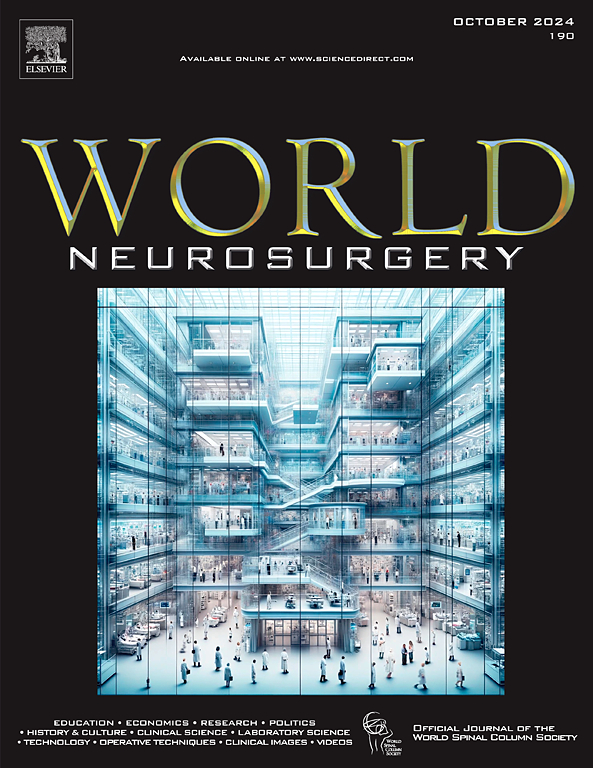Utilization of a Telemetric Prechamber in the Management of Patients with Normal Pressure Hydrocephalus
IF 1.9
4区 医学
Q3 CLINICAL NEUROLOGY
引用次数: 0
Abstract
Background and Objectives
Normal pressure hydrocephalus is a preventable and treatable cause of dementia. A telemetric prechamber allows individually tailored ventriculoperitoneal shunt valve adjustments in patients treated with the shunting procedure.
Methods
In this pilot, prospective randomized trial, 33 adult patients were divided into Group A (with an implanted telemetric prechamber) and Group B (without an implanted telemetric prechamber). The overall condition, Mini-Mental-State-Examination score, and gait test were evaluated 3, 6, 9, and 12 months after surgery. Additionally, the total number of ventriculoperitoneal shunt valve adjustments and their impact on the patient’s condition (assessed by the idiopathic normal pressure hydrocephalus scale) were assessed.
Results
There were no differences in the proportion of patients showing improved gait, cognitive functions, or incontinence. Patients with a telemetric prechamber underwent significantly more valve adjustments (1.6 ± 1.1 vs. 0.8 ± 0.6; P = 0.037). Also, a greater difference (reduction) in the shunt initial and final valve setting was observed in the prechamber group (30.71 ± 24.95 vs. 15.26 ± 13.07 mm H2O; P = 0.049).
Conclusions
A telemetric prechamber allowed more valve adjustments during the follow-up period and a greater difference (reduction) between the initial (perioperative) and final valve pressure settings. However, there was no difference in functional parameters between the groups at any time point of the study.
遥测预室在常压脑积水治疗中的应用。
背景/目的:正常压力脑积水(NPH)是导致痴呆症的一个可预防和可治疗的原因。通过遥测前腔,可对接受分流术治疗的患者进行量身定制的脑室腹腔(VP)分流阀调整:在这项前瞻性随机试验中,33 名成年患者被分为 A 组(植入遥测前腔)和 B 组(未植入遥测前腔)。分别在术后 3、6、9 和 12 个月对患者的整体状况、迷你智力状态检查(MMSE)评分和步态测试进行评估。此外,还评估了VP分流阀调整的总次数及其对患者病情的影响(用INPH量表评估):结果:步态、认知功能和大小便失禁情况得到改善的患者比例没有差异。使用遥测前腔的患者接受瓣膜调整的次数明显增多(1.6 ± 1.1 vs. 0.8 ± 0.6,p = 0.037)。此外,分流初始瓣膜设置和最终瓣膜设置的差异(减少)在前室组中也更大(30.71 ± 24.95 vs 15.26 ± 13.07 mm H2O,p = 0.049):结论:在随访期间,使用遥测前腔可对瓣膜进行更多调整,初始(围手术期)和最终瓣膜压力设置之间的差异(降低)更大。然而,在研究的任何时间点,两组的功能参数均无差异。
本文章由计算机程序翻译,如有差异,请以英文原文为准。
求助全文
约1分钟内获得全文
求助全文
来源期刊

World neurosurgery
CLINICAL NEUROLOGY-SURGERY
CiteScore
3.90
自引率
15.00%
发文量
1765
审稿时长
47 days
期刊介绍:
World Neurosurgery has an open access mirror journal World Neurosurgery: X, sharing the same aims and scope, editorial team, submission system and rigorous peer review.
The journal''s mission is to:
-To provide a first-class international forum and a 2-way conduit for dialogue that is relevant to neurosurgeons and providers who care for neurosurgery patients. The categories of the exchanged information include clinical and basic science, as well as global information that provide social, political, educational, economic, cultural or societal insights and knowledge that are of significance and relevance to worldwide neurosurgery patient care.
-To act as a primary intellectual catalyst for the stimulation of creativity, the creation of new knowledge, and the enhancement of quality neurosurgical care worldwide.
-To provide a forum for communication that enriches the lives of all neurosurgeons and their colleagues; and, in so doing, enriches the lives of their patients.
Topics to be addressed in World Neurosurgery include: EDUCATION, ECONOMICS, RESEARCH, POLITICS, HISTORY, CULTURE, CLINICAL SCIENCE, LABORATORY SCIENCE, TECHNOLOGY, OPERATIVE TECHNIQUES, CLINICAL IMAGES, VIDEOS
 求助内容:
求助内容: 应助结果提醒方式:
应助结果提醒方式:


